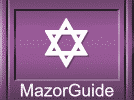|



|
Bar
Mitzvah Services and Ritual Ceremonies at Synagogue
Reform Perspective
by Rivka C. Berman
Which Service is Appropriate for a Bar/Bat Mitzvah
If you
haven’t done the advance work, don’t panic. Just about any service is
appropriate for a bar mitzvah. Saturday mornings is the most common choice.
Friday night, when the Torah is read as well, is another time. Saturday
afternoon is traditional time for Torah reading. Some congregations will
schedule an afternoon bat mitzvah close to the end of Shabbat when a havdalah
service can be held. Havdalah bar mitzvahs perturb some rabbis because reading
the Torah so late in the evening is not the normal reading time. Reading the
Torah outside of a service could turn the practice into a show instead of a part
of worship.
Although many Reform congregations are limited to Shabbat and holiday services,
the Torah is traditionally read on Monday and Thursday mornings too. Special
Torah readings are set for Rosh Chodesh, the beginning of each Jewish month, all
of Chanukah, Passover, Sukkot, and Shavuout. Rosh Hashannah and Yom Kippur
feature Torah readings, but synagogues don’t generally permit bnei mitzvah
celebrations during High Holiday services.
In some congregations, a bat mitzvah celebrant will read a short version of her
portion on Friday night (to practice) and the whole shebang on Saturday morning.
Another time to get in some reading is to read the haftarah, a weekly reading
from the Prophets, at the Friday night service. (It is traditionally read at the
Shabbat morning service.)
~~~~~~~~~~~~~~~~~~~~~~~~~~~~~~~~~~~~~~~~~~~~
Even if participation is limited during the service,
the party’s menu and structure can reflect whatever ethnic heritage and
traditions you desire.
Hagba – Raising the Torah
After the reading is finished, the Torah is lifted in a ritual called “hagba,”
meaning “to elevate” Hagba requires strength.
The 20 lb. Torah hoisted with three columns of text showing. When the Torah is
aloft, many congregations will say, “This is the Torah which Moses set before
the Children of Israel, according to God’s word as given to Moses.”
G’lilah – Tying the Torah
A special binder is used to wrap the Torah scroll. In some communities a
Torah tie, known as a wimple, was created from a newborn’s swaddling blanket and
embroidered with the baby’s name and birth date. The was wimple personalized for
the baby, used at the bar mitzvah service, and stored in the synagogue as a sort
of membership archive.
Haftorah – A Reading from the Prophets
Following the Torah reading, the haftorah will be chanted. This short
portion is a selection from the prophet’s writings. (There are 19 books of
prophetic writings in the Jewish Bible. Twelve of the minor prophetic accounts,
like Jonah, are gathered into one book. Isaiah, Jeremiah, Ezekiel are some of
the major volumes.) Haftarot has some connection to a theme from the Torah
reading. It’s interesting to speculate what the link is.
Reading the haftarah is somewhat easier than the Torah. For one thing, the
Hebrew words of the haftarah have vowels and are generally printed in book form,
instead of the large-format, multi-column Torah scroll layout. Furthermore, the
haftarah’s traditional tune is more sing-song and less varied than the Torah
trop.
Jews began the haftarah tradition around 200 C.E. Some say it was begun in
response to despotic bans on Torah reading. Or the custom may have begun as a
sort of sermon on the Torah portion that was just read.
Click
Here to Search For
Bar & Bat Mitzvah Service


|
|







